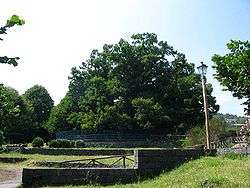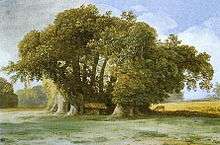Hundred Horse Chestnut



Coordinates: 37°45′00.7″N 15°7′49.4″E / 37.750194°N 15.130389°E
The Hundred-Horse Chestnut (Italian: Castagno dei Cento Cavalli; Sicilian: Castagnu dê Centu Cavaddi) is the largest and oldest known chestnut tree in the world.[1][2] Located on Linguaglossa road in Sant'Alfio, on the eastern slope of Mount Etna in Sicily[3] — only 8 km (5.0 mi) from the volcano's crater — it is generally believed to be 2,000 to 4,000 years old (4,000 according to the botanist Bruno Peyronel from Turin).[4] It is a Sweet Chestnut (Castanea sativa, family Fagaceae). Guinness World Records has listed it for the record of "Greatest Tree Girth Ever", noting that it had a circumference of 57.9 m (190 ft) when it was measured in 1780. Above-ground the tree has since split into multiple large trunks, but below-ground these trunks still share the same roots.
The tree's name originated from a legend in which a queen of Aragon and her company of one hundred knights, during a trip to Mount Etna, were caught in a severe thunderstorm. The entire company is said to have taken shelter under the tree.[3][5]
Literary allusions
The tree and its legend have become the subject of various songs and poems, including the following Sicilian-language description by the Catanese poet Giuseppe Borrello (1820–1894):
| Sicilian | English |
|---|---|
| Un pedi di castagna | A chestnut tree |
| tantu grossu | was so large |
| ca ccu li rami so' forma un paracqua | that its branches formed an umbrella |
| sutta di cui si riparò di l'acqua, | under which refuge was sought from the rain |
| di fùrmini, e saitti | from thunder bolts and flashes of lightning |
| la riggina Giuvanna | by Queen Giuvanna |
| ccu centu cavaleri, | with a hundred knights, |
| quannu ppi visitari Mungibeddu | when on her way to Mt Etna |
| vinni surprisa di lu timpurali. | was taken by surprise by a fierce storm. |
| D'allura si chiamò | From then on so was it named |
| st'àrvulu situatu 'ntra 'na valli | this tree nestled in a valley and its courses |
| lu gran castagnu d'i centu cavalli. | the great chestnut tree of one hundred horses.[6] |
Another Catanese poet, Giuseppe Villaroel (1889–1965), described the tree in the following sonnet (written in Italian):
| Italian | English | |
|---|---|---|
| Dal tronco, enorme torre millenaria, | From the trunk, huge millenary tower, | |
| i verdi rami in folli ondeggiamenti, | the green branches in mad waves, | |
| sotto l'amplesso quèrulo dei venti, | under the chattery embrace of the winds, | |
| svettano ne l'ampiezza alta de l'aria. | lance into the air's tall expanse. | |
| Urge la linfa, ne la statuaria | The sap rises in the statuesque | |
| perplessità de le radici ergenti, | astonishment of erect roots, | |
| sotto i lacoontei contorcimenti, | under Laocoön-like contortions, | |
| dal suolo che s'intesse d'orticaria. | from a nettle-woven soil. | |
| E l'albero - Briareo lignificato - | And the tree - wooden Briareus - | |
| ne lo spasimo atroce che lo stringe | in the throes of the invisible | |
| con catene invisibili alla terra, | fetters that bind it to the earth, | |
| tende le braccia multiple di sfinge | strains its many limbs as a sphynx | |
| scagliando contro il cielo e contro il fato | hurling against the sky and against fate | |
| una muta minaccia ebbra di guerra. | a voiceless threat sodden with war. | |
References
- ↑
 This article incorporates text from a publication now in the public domain: Chisholm, Hugh, ed. (1911). "article name needed". Encyclopædia Britannica (11th ed.). Cambridge University Press.
This article incorporates text from a publication now in the public domain: Chisholm, Hugh, ed. (1911). "article name needed". Encyclopædia Britannica (11th ed.). Cambridge University Press. - ↑ "Chestnut Dinner in the Mountains of Italy". Barilla online. 2005. Archived from the original on 2006-10-18. Retrieved 2006-12-22.
- 1 2 Senna, Luciana (2005). Authentic Sicily. Touring Editore. p. 112. ISBN 88-365-3403-1..
- ↑ Lewington, Anna; Edward Parker (2002). Ancient Trees: Trees That Live for 1,000 Years. Sterling Publishing Co. p. 92. ISBN 1-85585-974-2.
- ↑ The Chestnut tree of Mount Etna, detailed account of the tree, its state and its surroundings, written by Wm. Rushton on June 29, 1871.
- 1 2 "Poesie sul Castagno dei Cento Cavalli". (Sicilian) Catania Natura. Dipartimento di Botanica, University of Catania. Retrieved 2006-12-22.
External links
- "Various illustrations of the tree throughout history". Archived from the original on May 9, 2006. Retrieved December 22, 2006.
